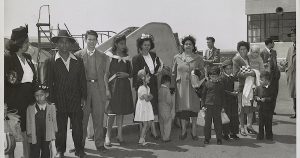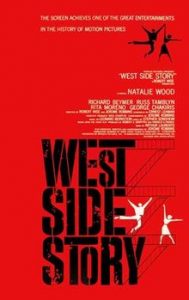The popular American musical inspired by William Shakespeare’s play Romeo and Juliet, West Side Story, is a film by Robert Wise and Jerome Robbins, written by Ernest Lehman, and produced by Wise. The film first came out in 1961 as an adaptation of the 1957 Broadway musical and was popularized most recently with its newest rendition in 2021. West Side Story depicts the Puerto Rican experience in their country of origin in comparison to living in America. From the Spanglish and the Puerto Rican dialect portrayed in the film to the Spanish instruments and rhythm used in the songs and style of dance, it distinguishes the barriers between the Puerto Rican immigrants families and the “white folk” from New York/ America. 1
Some of the main themes represented in the film include:
- the fear of immigrants
- disputes with the police
- the toxicity of racism/ racial unrest
- urban gang violence
- interracial relationships
These themes are only a start to the voice of Latinx rising above about day to day issues. The theme of love trumps any barriers that may stand in the way of it and ultimately bring two opposing sides together. It is an urgent matter with social concerns that can be seen today.2
The music conveyed especially in the lyrics illustrates the immigrant experience of moving to America for a better life to live the American dream. In this post we center on the song from West Side Story, “America,” where it begins hopeful with the expectations of:
“Skyscrapers bloom in AmericaCadillacs zoom in AmericaIndustry boom in America”
It then transitions to the reality that most immigrant families face when coming to America:
“Here you are free and you have prideLong as you stay on your own sideFree to do anything you chooseFree to wait tables and shine shoes:
This is similar to a story my Grandmother told me about how she came to America thinking that she would have so many opportunities in the land of freedom and she found herself cleaning offices at a university. When my Grandmother’s sister would talk to her about wanting to come to America, she would tell her all the opportunities that arose for her and that she is even going to university, hiding the fact that she was working as a custodian at a university in truth. There are a lot of misconceptions that arise and as is seen in the film, it can take a lot of hard work, dedication, and time to survive in the environment that is America.
West Side Story also incorporates other well known American songs such as “Somewhere” a popular songs sung by Barbara Streisand. There are correlations with the lyrics and the intent of bridging the two sides, immigrant versus American. The styles of dress and the accents allude to the time period norms and styles of the Puerto Rican culture.
1.) Lincoln Mayorga and Distinguished Colleagues. Sheffield Lab, 2008. Alexander Street. Web. 20 Sep. 2023.1
2.) Plays the shows 2. Fabulous, 2006. Alexander Street. Web. 20 Sep. 2023. 2
3.) “West Side Story.” YouTube, YouTube, 15 May 2013, https://www.youtube.com/watch?v=_e2igZexpMs. Accessed 20 Sept. 2023.3


